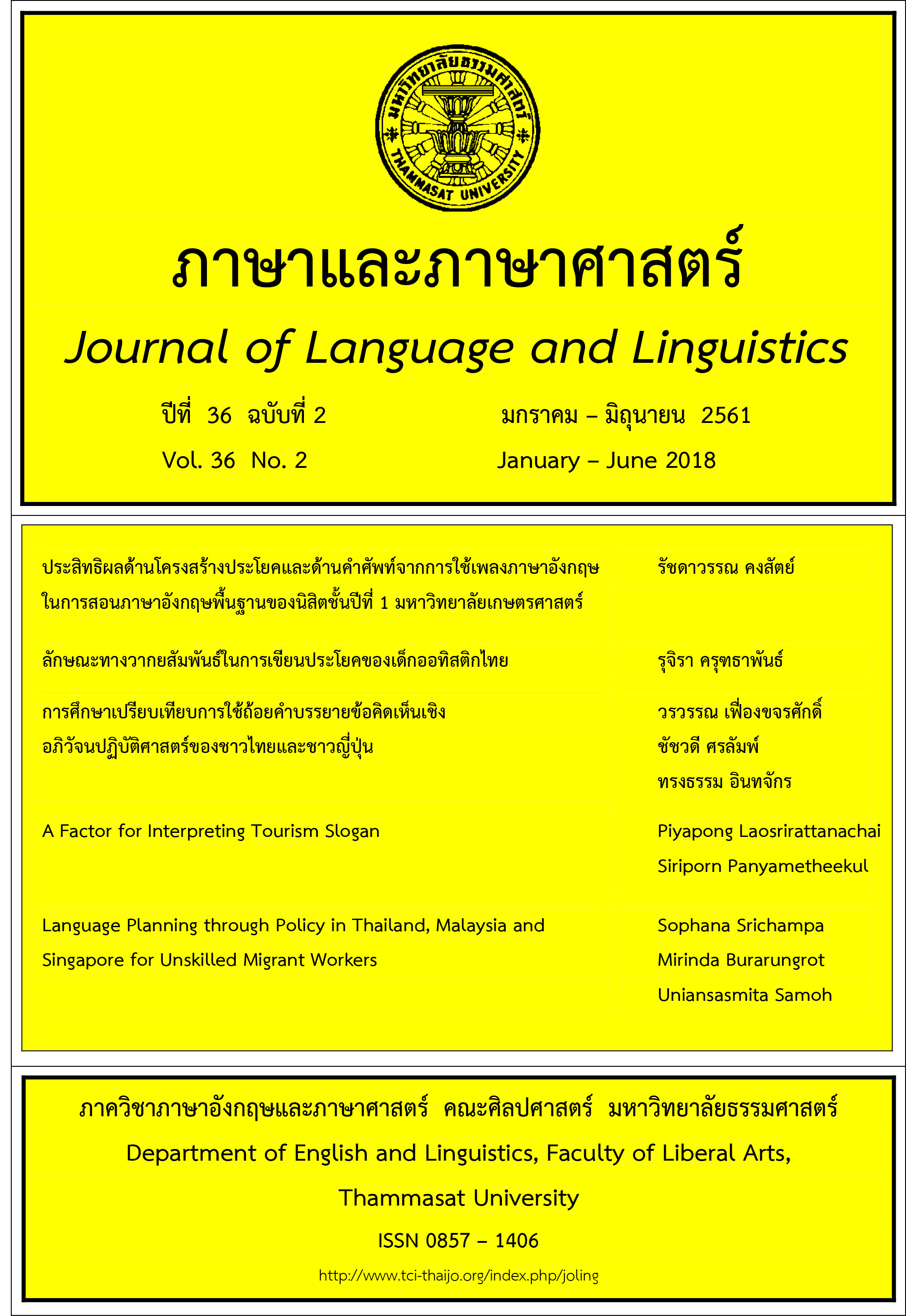A Comparative Study of Metapragmatic Commentary Used by Thais and Japanese
Main Article Content
Abstract
In daily life, speakers oftenuse language to talk about, or to comment on, their use of language in order to maintain effective interaction. The present article examines such commentary called “metapragmatic commentary” that occurs during Thai and Japanese group discussions. The results revealed that the purposes of metapragmatic commentary used among both Thai and Japanese speakers included 3 major goals: assessing speech activities, organizing talk, and clarifying communicative intention. These purposes were associated with3 topics of awareness functions: appropriateness of language use, discourse organization, and illocutionary functions. In addition, the metapragmatic commentary used by Thai and Japanese reflects different styles of communication. Thai speakers’ communication style tends to be more direct, while Japanese prefer to modify their opinion to be consistent with others by expressing hesitation.
Article Details
บทความทุกบทความเป็นลิขสิทธิ์ของภาษาและภาษาศาสตร์
References
Bakhtin, M. (1981). The dialogical imagination: Four essays. Austin, TX: Texas University Press.
Blum-Kulka, S. & Sheffer, H. (1993). The metapragmatic discourse of American-Israeli families at dinner. In G. Kasper, & S. Blum-Kulka (Eds.), Interlanguage pragmatics
(pp. 196-211). Oxford: Oxford University Press.
Bublitz, W. (2006). It utterly boggles the mind: Knowledge, common ground and coherence. In H. Pishwa (Ed.), Language and memory: Aspects of knowledge
representations (pp. 359-386). Berlin: De Gruyter.
Bublitz,W., & Hübler, A. (Eds.). (2007). Metapragmatics in Use. Amsterdam: John Benjamins
Caffi, C. (1998). Metapragmatics. In J. L. Mey (Ed.), Concise encyclopedia of pragmatics (pp. 581-586). Amsterdam: Elsevier.
Caffi, C. (2007). Mitigation. Amsterdam: Elsevier.
Carranza, I. (2008). Metapragmatics in a courtroom genre. Pragmatics, 18, 169-188.
Culpeper, J., & Haugh, M. (2014). Pragmatics and the English language. London: Palgrave Macmillan.
Goffman, E. (1981). Forms of talk.Philadelphia, PA: University of Pennsylvania Press.
Goodwin, C., & Goodwin, M. (1987). Concurrent operations on talk: Notes on the interactive organization of assessments. IPrA Papers in Pragmatics, 1, 1-55.
Grundy, P. (2008). Doing pragmatics (3rd edition). London: Hodder Education.
Hasagewa, Y. (2006). Embedded soliloquy and affective stances in Japanese. In S. Suzuki (Ed.), Emotive communication in Japanese (pp. 209-230). Philadelphia, PA: John Benjamins.
Haugh, M. (2005). The importance of ‘place’ in Japanese politeness: Implications for cross-cultural and intercultural analyses. Intercultural Pragmatics, 2, 41-68.
Hayashi, M., & Hayano, K. (2013). Proffering insertable elements: A study of other-initiated. In M. Hayashi, G. Raymond & J. Sidnell (Eds.), Conversational repair and human
understanding (pp. 292-321). Cambridge: Cambridge University Press.
Hofstede, G. (2011). Dimensionalizing cultures: The Hofstede model in context. Online Readings in Psychology and Culture, 2(1). Retrieved from
http://dx.doi.org/10.9707/2307-0919.1014.
Hongladarom, K. (2007). “Don’t blame me for criticizing you…”: A study of metapragmatics comments in Thai. In W. Bublitz & A. Hübler (Eds.),
Metapragmatics in Use (pp. 29-47). Amsterdam: John Benjamins.
Hübler, A. (2011). Metapragmatics. In W. Bublitz & N. R. Norrick (Eds.), Foundations of pragmatics (pp. 107-138). Berlin: De Gruyter Mouton.
Katagiri, Y., & Shimojima, A. (2002). Display acts in grounding negotiations. In K. Kataoka, & S. Ide (Eds.), Bunka intarakkushon gengo (pp. 65-75). Tokyo: Hitsuzisyobo.
Keisanen, T., & Kärkkäinen, E. (2014). Stance. In W. Bublitz, A. Jucker & K. Schneider (Eds.), Handbooks of Pragmatics (pp. 295-322). Berlin: De Gruyter Mouton.
Kivik, P., & Vogelberg, K. (2003). Contrasts between the contrasters: What discussion groups can tell us about discourse pragmatics. In K. M. Jaszczolt & K. Turner
(Eds.), Meaning through language contrast (pp. 73-401). Amsterdam: John Benjamins.
Komin, S. (1990). Psychology of the Thai people: Values and behavioral patterns.Bangkok: Research Center, National Institute of Development Administration.
Kondo, S. (2014). Compliments and responses to compliments in L2 and L1 speakers' interaction: A Discursive Approach. Sophia University Junior College Division, Faculty
Journal, 34, 19-43.
Mey, J. (1993). Pragmatics. Oxford: Basil Blackwell.
Miller, L. (2000). Negative assessments in Japanese-American workplace interaction. In H. Spencer-Oatey (Ed.), Culturally speaking: Culture, communication and politeness
theory (pp. 227-240). London: Continuum.
Morita, E. (2012). “This talk needs to be registered”: The metapragmatic meaning of the Japanese interaction particle ‘yo’. Journal of Pragmatics, 44, 1721-1742.
Overstreet, M. (2010). Metapragmatics. In L. Cumming (Ed.), The Pragmatics Encyclopedia (pp. 266-268). New York, NY: Routledge.
Overstreet, M., & Yule, G. (2002). The metapragmatics of ‘and everything’. Journal of Pragmatics, 34, 785-794.
Penz, H. (2007). Building common ground through metapragmatic comments in international project work. In W. Bublitz & A. Hübler (Eds.), Metapragmatics in use
(pp. 263-292). Amsterdam: John Benjamins.
Silverstein, M. (1993). Metapragmatic discourse and metapragmatic function. In J. Lucy (Ed.), Reflexive language: Reported speech and metapragmatics (pp. 33-58).
Cambridge: Cambridge University Press.
Suzuki, S. (2007). Metapragmatic function of quotative markers in Japanese. In W. Bublitz & A. Hübler (Eds.), Metapragmatics in use (pp. 73-85). Amsterdam: John Benjamins.
Verschueren, J. (2000). Notes on the role of metapragmatic awareness in language. Pragmatics, 10, 439-456.
西條美紀 (1999)『談話におけるメタ言語の役割』風間書房
杉戸清樹 (1989)「言語行動についてのきまりことば」『日本語学』8, 4-14.
李婷 (2013)「メタ言語表現の『文脈展開機能』」『早稲田日本語研究』22, 1-12.


